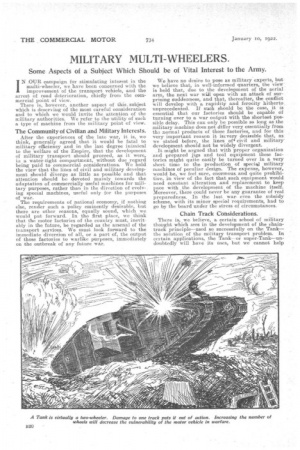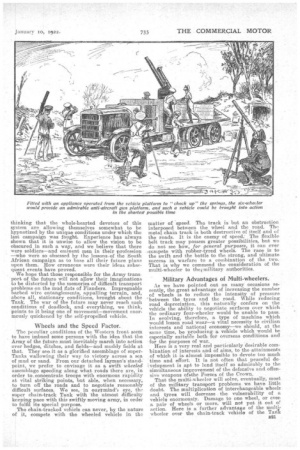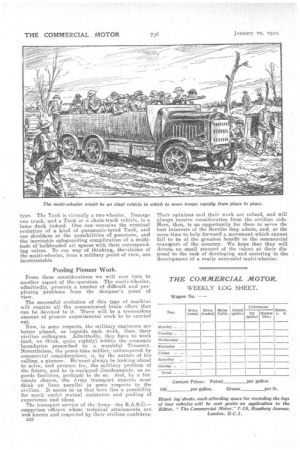MILITARY MULT1-WHEELERS4
Page 18

Page 19

Page 20

If you've noticed an error in this article please click here to report it so we can fix it.
Some Aspects of a Subject Which Should be of Vital Interest to the Army.
IN OUR campaign for stimulating interest in the multi-wheeler, we have been concerned with the improvement of the transport vehicle, and the arrest of road deterioration, chiefly from the commercial point of view.
There is, however, another aspect of this_subject which is deserving of the most careful consideration and to whieh we would invite the attention of the military authorities. We refer to the utility of such a type of machine from the military point of view.
The Community of Civilian and Military Interests.
After the experiences of the late war, it is, we think, generally agreed that it would be fatal to military efficiency and in the last degree inimical to the welfare of the Empire' that the development of military transport should proceed, as it were, in a water-tight compartment, without due regard being paid to commercial considerations. We hold the view' that the lines of civil and military development should diverge as little as possible and that attention should be devoted mainly towards the adaptation of commercially useful machines for military purposes, rather than in the direction of evolving special machines, useful only for the purposes of war.
The requirements of national economy, if nothing else, render such a policy eminently desirable, but there are other reasons, equally sound, which we would put forward. In the first place, we think that the motor factories of the country must, inevitably in the future, be regarded as the arsenal of the transport services. We must look forward to the immediate diversion of all, or a part of, the output of those factories to warlike purposes, immediately on the outbreak of any future war.
We have no desire to pose as military experts, but we believe that, in well-informed quarters' the view is held that, due to the development of the aerial arni the next war will open with an attack of surprising suddenness, and that, thereafter, the conflict -will develop with a rapidity and ferocity hitherto unprecedented. If such should be the case, it is essential that our factories should be capable Of turning over to a war output with the shortest possible delay. This can only he possible se long as the military machine does not differ very essentially from ths normal products of those factories, and for this -very important reason it isevery clesivable that, as we stated before the lines off civil and military. development should not be widely divergent.
It might be arffued that with proper organization and prepared Jigs and tool equipment these factories might quite easily be turned over in a very short time to the production of speciail military machines of peculiar design. The expense, however, would be, we feel sure, enormous and quite prohibitive, in view of the fact that such equipment would need constant alteration and replacement to keep pace with the development of the machine itself. Moreover, there could never be any guarantee of real preparedness. In the last wareven the subsidy scheme, with its minor special requirements, had to go by the board under the stress of circumstances.
Chain Track Considerations.
There is, we believe, a certain school of military thought which sees in the development of the chaintrack principle—used so successfully on the Tank— the solution of the military transport problem. In certain applications, the Tank—or super-Tank—undoubtedly will have its Uses, but we cannot help thinking that the whole-hearted devotees of this system are allowing themselves somewhat to be hypnotized by the unique conditions under which the last campaign was fought. Experience has always shown that it is unwise to allow the vision to be obscured in such a way, and we believe that there were soldiers—and eminent men in their profession —who were so obsessed by the lessons of the South African campaign as to base all their future plans upon them. How erroneous were their ideas subsequent events have proved.
We hope that those responsible for the Army trans. port of the future will not allow their imaginations to be distorted by the memories of difficult transport problems on the mud flats of Flanders. Impregnable barbed wire entanglements, appalling terrain, and, above all, stationary conditions, brought about the Tank. The war of the future may never reach such conditions of deadlock, and everything, we think, points to it being one of movement—movement enormously quickened by the self-propelled vehicle.
Wheels and the Speed Factor.
The peculiar conditions of the Western front seem to have imbued some persons with the idea that the Army of the future must inevitably march into action over hedges, ditches, and fields—and muddy fields at that. They see it as a glorified assemblage of superTanks wallowing their way to victory across a sea of mud or sand. From our detached layman's standpoint, we prefer to envisage it as a swift wheeled assemblage speeding along what roads there are, in order to conoentrate troops with enormous rapidity at vital striking points, but able, when necessary, to turn off the roads and to negotiate reasonably difficult surfaces. We see, in ourrmind'i eye, the super chain-track Tank with the utmost difficulty keeping pace with this swiftly moving army, in order to fulfil its special purpose.
The chain-tracked vehicle can never, by the nature of it, compete with the wheeled vehicle in the
matter of speed. The track is but an obstruction interposed between the wheel and the road. The metal chain track is both destructive of itself and of the roads. It is the enemy of speed: The flexible belt track may possess greater possibilities, but we do not see how, for general purposes, it can ever cenipete with rubber-tyred wheels. The race is to the swift and the battle to the strong, and ultimate success in warfare to a combination of the two. That is why we commend the consideration of the multi-wheeler to the military authorities.
Military Advantages of Multi-wheelers.
As we have pointed out on many occasions recently, the great advantage of increasing the number of wheels is to reduce the intensity of pressure 'between the tyres and the road. While reducing road depreciation, this naturally confers on the vehicle the ability to negotiate surfaces over which the ordinary four-wheeler would be unable to pass. In evolving, therefore, a type of machine which would lessen road wear—a vital necessity to civilian interests and national economy—we should, at the same time, be producing a vehicle which would be especially suitable both for overseas conditions and for the purposes of war.
Here is a very real and particularly desirable combination of interests and of aims, to the attainments of which it is almost impossible to devote too much time and effort. It is not often that peaceful development is apt to lend itself so admirably to the simultaneous improvement of the defensive and offensive weapons of•the Forces of the Crown.
That the multi-wheeler will solve, eventually, most of the military transport problems we have little doubt. The multiplication of interchangeable wheels and tyres will dec,rease the vulnerability of a vehicle enormously. Damage to one wheel, or even a pair of wheels or more, will not put it out of action. Here is a further advantage of the multi,. wheeler over the chain-track vehicle of the Tail type. The Tank is virtually a two-wheeler. Damage one track, and a Tank or a chain-track vehicle, is a lame duck indeed. One can.conceive the eventual evolution of a kind of pneumatic-tyred Tank, and one shudders at the possibilities of puncture, and the inevitable safeguarding complication of a multitude of bulkheaded air spaces with their corresponding valves. To our way of thinking, the.,claims of the multi-wheeler, from a military point of view, are incontestable.
Pooling Pioneer Work.
From these considerations we will now turn to another aspect of the:question. The multi-wheeler, admittedly, presents a number of difficult and perplexing problems from the designer's point of view.
The successful evolution of this type of machine will require all the concentrated brain effort that can be devoted to it. There will be a tremendous amount of pioneer experimental work to be carried out.
Now, in some respects, the military engineers are better placed, as regards such work, than their civilian colleagues. Admittedly, they have to work (and, we think, quite rightly) within the economic boundaries preseribed by a watchful Treasury. Nevertheless, the peace-time soldier, unhampered br commercial considerations, is, by the nature of his calling, a pioneer. He'must always be looking ahead to solve, and prepare for, the military problem of the future, and he is equipped (inadequately, as regards facilities, perhaps) to do so. And, by a fortunate chance, the Army transport experts must think on lines parallel in some respects to the civilian. It seems to us that here lies a possibility for much useful mutual assistance and pooling of experience and ideas.
The transport service of the Army—the R.A.S.0.— comprises officers whose technical attainments are well known and respected by their civilian confreres.
B22 Their opinions and their work are valued, and will always receive consideration from the civilian side. Here, then, is an opportunity for them to serve the best interests of the Service they adorn, and, at the same time to help forward a movement which cannot fail to be of the greatest benefit to the commercial transport of the country. We hope that they will devote no small amount of the talent at their disposal to the task of developing and assisting in the development of a really successful multi-wheeler.


































